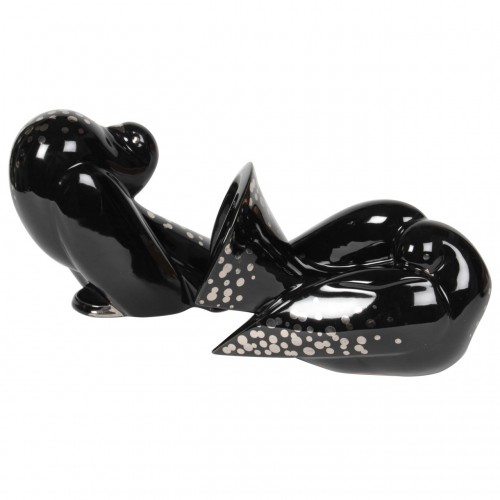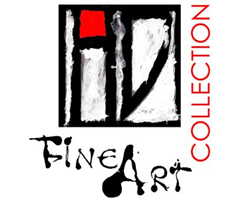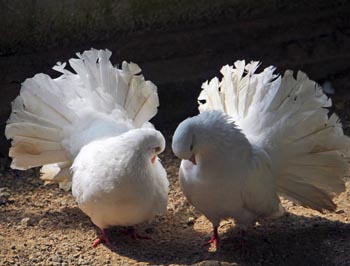Product Description
Jan et Joel Martel / Primavera French Art Deco Courting Fantail Pigeon Sculptures c.1930



JAN ET JOËL MARTEL (1896-1966) France
PRIMAVERA Paris
Pair of courting Faintail Pigeon Sculptures c.1925-30
Black glazed earthenware with silver / platinum decorative dot motif.
Marks: PRIMAVERA FRANCE, 12684
For related model: The Art Deco Style in Household Objects, Architecture, Scupture, Graphics, Jewelry, Theodore Menten (New York: Dover, 1972), p. 179.
For more information see: Joël et Jan Martel: sculpteurs 1896-1966, Christophe Vital, et al. (Paris: Gallimard / Electa, 1996), pp. 127-9
H: 8 1/16” x L: 9” x D at tail: 5 1/4”
H: 7 1/8” x L: 10” x D at tail: 5 1/4”
Jan & Joël Martel (the Martel Brothers/Twins, born in Nantes on 5 April 1896, both died in 1966)
The twin Martel sculptors were among the founding members of Union des Artistes Modernes, and their original works include ornamental sculptures, statues, monuments and fountains displaying characteristics typical of the Art Déco and Cubist periods. The brothers took part in a number of Paris exhibitions including the Salon des Indépendants, Salon d’Automne, Salon des Tuileries and the Exposition des Arts Décoratifs in 1925. In 1932, they created the Claude Debussy monument which sits on the boulevard Lannes in Paris. Between 1924-1926, Robert Mallet-Stevens designed a studio for the Martel twins at 10 Rue Mallet-Stevens in Paris’ 16th Arrondissement.
Jan et Joel Martel / Primavera French Art Deco Courting Fantail Pigeon Sculptures c.1930
INGEGERD TORHAMN (1898-1994) Sweden
Modernist rug c. 1930
Hand-knotted wool
Signed: it (Ingegerd Torhamn) lower left
Exhibited: Stockholm Exhibition 1930, Stockholmsutställningen 1930, Villa 42; V.I.P. in Swedish Design, Kalmar Konstmuseum 1996.
Illustrated: Katalog Över Bostadsavdelningen: Stockholms Utställningen 1930 (illustrated in situ) Stockholm Exhibition1930 (Stockholm: Tryckt Hos Bröderna Lagerström, Boktryckare, 1930) p. 149
Drawing illustrated: V.I.P. in Swedish Design: Axel Larsso, Ingegerd Torhamn, Inga Linden & Paula Sokolow, Arkiv for Svensk Formgivning, Kalmar Konstmuseum
For more information see: Svenska Textilier 1930, Stockholm 1930, Nils G. Wollin, plate nr. 50
Dimensions: 7’2” square
One of the ten rugs of her designs (including this rug as part of the music room) exhibited at the important Stockholm Exhibition of 1930 is now in the permanent collection of the Nationalmuseum in Stockholm.
Brassaï (1899-1984) Austria-Hungary [now Romania]
Paul Morand (1888-1976) France
“Paris de Nuit” (Paris After Dark) 1933
Published by Arts et métiers graphiques, Paris
Dimensions:
Book: H: 9 13/16” x W: 7 9/16”
Custom leather box: H: 10 5/8” x W: 8 5/8” x D: 1 3/8”
Custom silk slipcase: H: 11 21/32” x W: 9 5/8” x D: 2 7/16”
Brassaï is the pseudonym of Guyla Halász from Transylvania (Hungarian at the time of his birth, but currently part of Romania). Brassaï literally means: from Brasso (his native village). He decided to use this pseudonym in 1932, the year in which Paris de nuit was published. He had already been living in Paris for eight years, where he wrote articles for German magazines and met photographers such as Atget and André Kertész. Not until 1930 did he first begin to take photographs himself, immediately discovering his main subject: Paris.
He moved into an apartment on the corner of the Rue de la Glacière and the Boulevard Auguste-Blanqui in 1928, where Raymond Queneau also lived. He would go out at night with Queneau or other nocturnal people such as Léon-Paul Fargue, but Brassaï usually just walked through the abandoned streets and alleys of the city. He could only take 24 photographs per walk because the stack of glass photo plates would otherwise grow too heavy.
His nocturnal journeys yielded a wealth of photographs, which by now have gained the status of icons of modern photography. They were first published on 2 December 1932 by Arts et metiers graphiques, which was Charles Peignot’s publishing business. He was also the founder of the magazine Arts et metiers graphiques (1927-1939) in which articles on design, typography, illustration and advertising appeared. It was printed in an edition of 4000 copies: there were also printers associated with the editing staff, like Léon Pichon. Peignot was the president of type foundry Deberny et Peignot, and were in contact with the Union des Artistes Modernes (Cocteau, Gide, Sonia Delaunay, Maximilien Vox and others) and with poster designers such as Cassandre.
The first review of Paris de nuit was published in a Dutch newspaper, the Nieuwe Rotterdamsche Courant of 29 December 1932. An English edition of the photo book appeared in 1933 from Batsford Gallery in London. The photographs were also exhibited. Many photo books were to follow, including a book in 1960 about the graffiti on Parisian walls, which he had documented in his photographs since 1930. Not without reason did Henry Miller call him ‘the eye of Paris’. Jean Paulhan actually asserted that Brassaï had more than two eyes.
